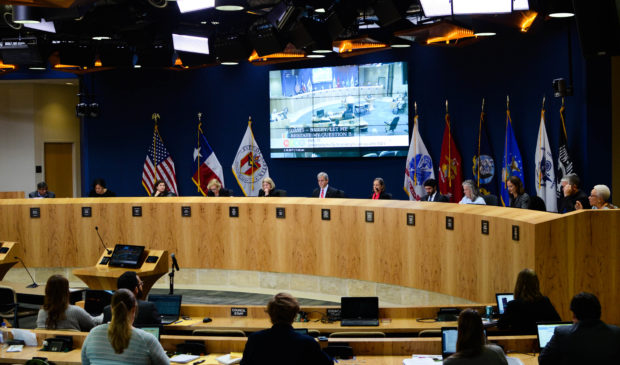Public speaks on land use code second draft
Wednesday, February 12, 2020 by
Ryan Thornton City Council opened the floor to public comment Tuesday, leading up to its second reading on the revised draft of the Land Development Code.
In total, there were 65 speakers, most of whom voiced objections of some sort to the proposed code rewrite.
Articulating a well-represented view on the new code, resident Bill Fowler said the new code will degrade Austin neighborhoods into “typical large city sameness” with expensive new homes while clogging streets with trash cans and cars. He urged Council to stop this by using its power to “not sell out to the newcomers.”
Alicia Weigel, a member of the Human Rights Commission and three-year Austin resident, rejected this dismissal of newcomers. She said she has spent her time here fighting for justice and sees the code as an opportunity to continue that fight by adopting tools to get better results out of new development while bracing for the future of climate change.
“If where we are now isn’t working for us, and hasn’t been working for us, then I’m not sure why we wouldn’t try to protect ourselves,” she said. “As a homeowner in Bouldin Creek who hears the fear of my neighbors in our neighborhood association meetings, I also fear my property taxes spiking by the condos coming in next door, but more pressingly, as someone who’s terrified for my future because of climate change, we don’t have the luxury anymore of the status quo.”
Awais Azhar, representing the housing advocacy group Planning Our Communities, said his organization is encouraged by the second draft’s opportunities for equitable development and affordable housing, specifically through adoption of Mayor Pro Tem Delia Garza’s equity overlay district in East Austin. He said further improvements could be made by mapping existing multifamily housing equivalent to their current use citywide.
Planning Our Communities has also asked for the termination of neighborhood conservation combining districts, a request echoed Tuesday by members of the Austin Justice Coalition.
Several coalition members called the code an opportunity to finally address historic segregation and racism by ending the use of exclusionary zoning districts like NCCDs, a tool that Larissa Rodionov said is still being used to “continue the legacy of racism and segregation.” Members of the coalition called for a sunset clause of the city’s Formal Title 25 zoning category, a catchall for special zoning districts that are too complex or politically sensitive to rezone under the new code.
The code revision team is using F25 zones for districts like planned development agreements that are generally outdated and not expected to be an authorized zoning district under the new code.
Brent Lloyd of the code revision team said there will be more information on the F25 zones following second reading. Leading up to final adoption, the team will provide translation tables of specific F25 zones and their nearest comparable zone under the new code, except in instances where zones are too site-specific to fall under a new zoning category. In that case, he said, the best practice will be to apply the most comparable zoning and later refine the zoning criteria after code adoption. In some cases, he said the city may need to get into small area planning to decide how to apply new zoning categories to F25 zones.
Kendra Garrett with Austin Justice Coalition and Planning Our Communities was also concerned about equity, saying renters, who make up a majority of city residents, “don’t get enough love” in city processes like this. While supporting much of the second draft, she said the proposed citywide density bonus program should include tenant protections like the right to return after redevelopment and the right to organize.
Some speakers also voiced concerns about losing protections for heritage trees along corridors and the need to preserve the tree canopy in the face of climate change.
David Sullivan, however, said the code stands to improve the city’s overall climate resilience.
“With regard to safety and the environment, I remind you that this code has new requirements that will lead to the capture of millions of gallons of stormwater,” Sullivan said. “In addition, by creating new housing in transit-rich and mixed-use areas, this can reduce driving per capita.”
David Foster with Clean Water Action said the organization approves of many of the second draft’s components, like the requirement of a drainage plan for sites with 50 percent or more impervious cover. The organization plans to continue working with the Watershed Protection Department to further refine drainage and retention regulations in the weeks to come.
Jessica Rollason, a resident of District 9, urged Council and residents to seek solutions that address the need for natural preservation of trees and critical watersheds while also creating new opportunities for housing.
“We have to prioritize equity and opportunity,” she said. “This means more housing and it means more units. We need more height, we need smaller units, smaller lots and less parking.”
This story has been changed since publication to correct the affiliation of Kendra Garrett. Photo by John Flynn.
The Austin Monitor’s work is made possible by donations from the community. Though our reporting covers donors from time to time, we are careful to keep business and editorial efforts separate while maintaining transparency. A complete list of donors is available here, and our code of ethics is explained here.
You're a community leader
And we’re honored you look to us for serious, in-depth news. You know a strong community needs local and dedicated watchdog reporting. We’re here for you and that won’t change. Now will you take the powerful next step and support our nonprofit news organization?




